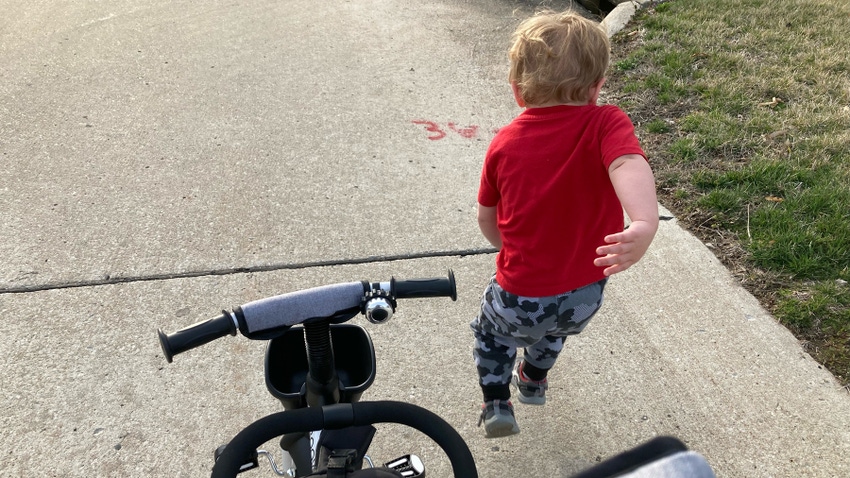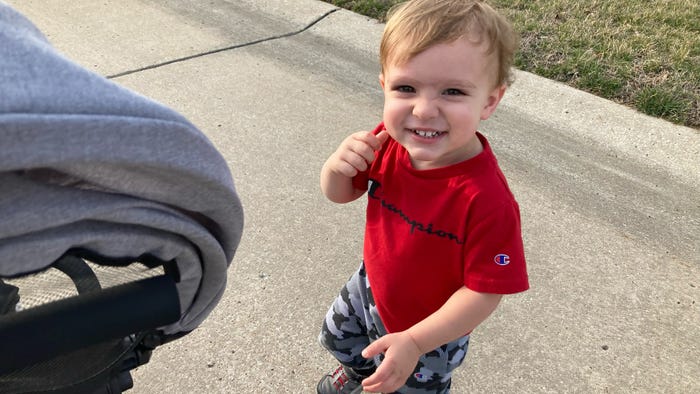
What would Temple Grandin do? I asked myself this while on a walk with my soon-to-be 2-year-old grandson as he darted in and out of the street. Could her low-stress cattle handling practices really be used on a child? This child?
First, I’ll admit I was out of my element. If we were on the farm, this outing would be easy—there is woven and barbed wire fencing to keep him within a perimeter. I blame my daughter and her husband for living in town, because now I must learn to adapt my child-handling management practices.
So, who better to look to than someone who keeps cantankerous cattle corralled, humanely?
For those of you who don’t know (or have been living under a rock), Temple Grandin is an animal behaviorist and Colorado State University professor who is a pioneer in the low-stress cattle handling movement. She traveled the country and world showing farmers and ranchers how to interact with animals in a way that does not cause them stress.
So, I put a few of her well-known dos and don’ts for cattle to the test on little humans. Here’s what I found:
Do calm down. This is some solid advice. Admittedly, I found every time I yelled “stop” and raced toward him, my grandson ran faster and laughed louder. I tried to use my quiet voice as Temple suggests and move toward him slowly, so as to not spook him. It worked — sometimes.
Do make first experiences pleasant. Temple says to introduce new things gradually to avoid making the animal anxious. I guess I could’ve returned home after he saw the first bird and left the dog for another walk, but fear is not in my grandson’s design. He aptly runs toward “firsts” — or anything, for that matter — grinning every step of the way.
Do move at a walk or trot. 100% agreement. And I’d stick with a walk. Those little legs run fast. And toddlers are so low to the ground that they are wicked agile, able to dart on a dime. At that point, they are on a dead sprint and you’re left holding the stroller. I suggest finding a steep hill. They only run so far — and you can catch them on the incline.

FOR THE GRINS: I will endure any amount of chasing my grandson, Grayson, around the block just to see that smile. Toddlers may test us, but they also light up our lives.
Don’t keep them alone. One of the most dangerous animals is the lone animal, according to Temple. From my younger days as a mom, I remember my two girls being easy to manage because they ran and played together. But walking in the city? Sorry, Temple, I’m stressed with one toddler. He’s going to be a lone calf.
Don’t select for temperament only. Well, that ship sailed. My grandson has his mom’s curiosity and his dad’s laser focus, which is a wicked combination when walking by a car, yard gnome or mailbox. There is no culling this one. He also has a little me in him — extreme excitement — so, he’s a keeper!
Don’t use a hot shot. OK. Temple says use a flag to drive cattle. I opted for the walk-behind tricycle to gently, sometimes a little forcefully, “guide” him to the side of the road. But still, not a hot shot. You’re welcome.
Overall, Temple has some great ideas that work well for low-stress handling of cattle and kids. Whether you’re a mom or grandma of toddlers in need of wrangling, try them out.
Still, is it wrong to save the hot shot for when they are older? Kidding, really, kidding. But, hey, there are alternatives. At least I’d be able to catch them with my three-wheel mobility scooter.
About the Author(s)
You May Also Like






